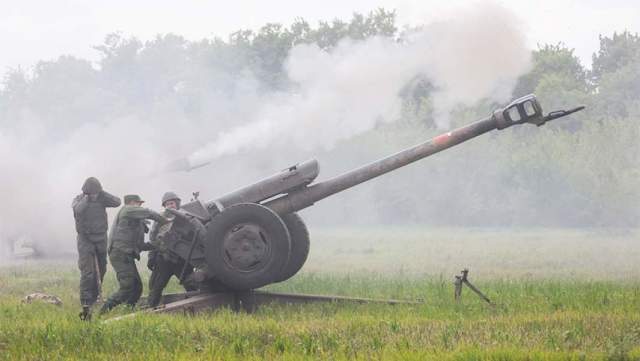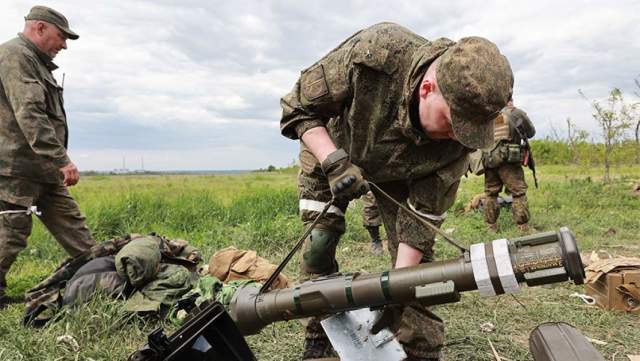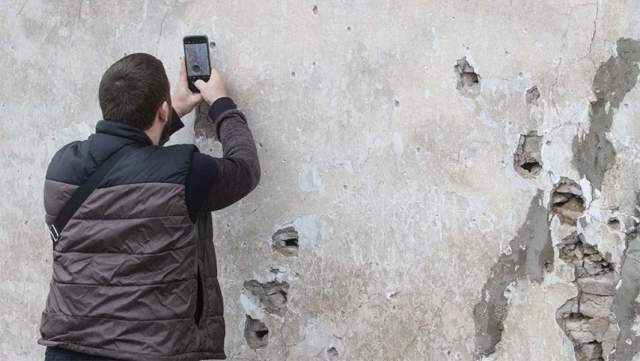The correspondent of Izvestia visited the positions of a howitzer battery near Svetlodarsk, where there are battles for the largest thermal power plant
Svetlodarsk — it is also called the "city of power engineers" — was liberated quickly and without much fighting at the end of May. But now Ukrainians have gained a foothold in numerous strongholds nearby, as well as on the territory of the Uglegorsk thermal power plant — one of the largest in Europe. In this direction, the Allied forces are methodically pushing through the defense lines of the VFU. Here, artillery plays a major role in the battles. How in the LPR they fight with long-range foreign artillery systems, how they shoot down Ukrainian "Dots—U" and rockets, - in the Izvestia report
Hidden positions
Although the area of Svetlodarsk is already the territory of the DPR, the troops of the republics here, as during the Chernukhino-Debaltsevo offensive operation in 2015, act together. Even in the established hot and dry weather, only cross-country vehicles can pass to the front line. Therefore, in Debaltseve, we transfer to the tent army "Ural" of the Lugansk People's militia. A long way along country roads ends at perfectly camouflaged positions of towed guns.
— The enemy has retreated to the dam and is holding the Uglegorsk thermal power plant, — says an LPR artillery officer with the call sign Alligator. — We are trying to get rid of him with jewelry without damaging the power plant itself. Until recently, we had the same weapons — the legacy of the USSR. Now Europe and the United States are actively helping them, throwing up new weapons. First of all, the range has changed. And artillery is always chasing the range. Whoever has more of it is in the black.
In the LPR, they are fighting the new long-range systems of Ukraine in a comprehensive manner, through the interaction of the armed forces. Artillery alone cannot be defeated in such a confrontation, the officers note, so both aviation and long-range missile systems are connected here.

Photo: TASS/Stanislav Krasilnikov
Image source: iz.ru
— The infantry believes that the life of the gunners is easy, — says the Alligator. — And you try to work all day at this infernal anvil! Drag almost 30-kilogram shells, lay them out on the ground and collect them from it. Move guns from position to position. All this in the heat, cold, slush. Exhausting work. And there is no one to replace you in the calculation. If you get sick or injure your knee, you will still have to perform your duties.
A gunner with the call sign Pirate commands a platoon of D-20 guns. He used to work with smaller, 122-mm D-30 howitzers, but recently successfully retrained for a new model for himself. His calculations are mostly reservists, former miners and even a seller from the market. The Pirate himself has been fighting since 2014.
— The D-20 howitzer has a range of 17 km with a conventional projectile and 24 with an active—reactive one, - the platoon commander explains. — We work from it on platoon strongpoints, equipment, armored vehicles, enemy trenches. The intensity of work varies, there are five shells per gun per day, and sometimes fifty. We are constantly changing positions. Worked out — moved to new ones so as not to get under return fire, and then — camouflage. It is very important.
— Multicopters do not reach our positions, — adds the Pirate. — But aircraft-type drones sometimes appear. Therefore, we are also covered by air defense.
Standing next to the D-20, covered with a camouflage net and littered with freshly cut tree branches, is hardly distinguishable even up close, from 15 meters. Only the big wheels give it away. Before combat work, the disguise is quickly disassembled and the gun is quickly made for the first, sighting shot.
According to the coordinates of the target issued by the headquarters, the first projectile leaves. Active headphones effectively extinguish the sound of a powerful howitzer shot, radically reducing the impact on the ears and at the same time allowing you to clearly hear all commands. They also help to feel the enemy's return, "incoming" fire in advance. But few people have such here. The officer complains that there are always problems at customs with the passage of protective equipment already collected for artillery by volunteers.

Photo: IZVESTIA/Pavel Volkov
Image source: iz.ru
The gunners are in no hurry to make the second shot. The projectile flies to the target for almost 50 seconds. A few more are required by the spotter on the front line to determine the corrections. Only after confirmation by radio of the target's cover does the processing of its additional charges begin.
Interceptions in the sky
On the way back from the artillery positions, we stop at a fresh crater — from the fall of the wreckage of the Ukrainian Tochka-U ballistic missile in Stakhanov.
The Ukrainian ammunition did not hit its target, but even the debris is very dangerous. A high-explosive fragmentation warhead that fell to the ground left a deep crater one and a half times the height of a man on the concrete platform of an abandoned gas station, far from any military facilities. People were not injured, but the trees around and several surrounding houses were hit. A two-storey residential building fifty meters from the funnel lost all the glass, large fragments pierced gas pipes, metal gates and pillars, and got deeply stuck in brick walls.
— At 3 a.m. on June 20, there was another attempt to shell a residential area of the city with a Tochka-U rocket with a high-explosive fragmentation part, — said the representative of the People's Militia of the LPR Fedor Sergeev. — The air defense units of the Luhansk People's Republic and Russia shot it down on approach. As a result of the fall of the warhead, nine residential buildings and communications near the crash site were damaged. Specialists of the gas industry are already completing their restoration.
In the spring, I visited the fall sites of the Ukrainian "Dots" in the LPR several times, but then the Kiev troops used only their cluster modifications. During the first month and a half, not a single high-explosive fragmentation variant was recorded, representatives of the Joint Center for Control and Coordination of the Ceasefire Regime and Stabilization of the Situation in the south-east of Ukraine told then.

Photo: TASS/Stanislav Krasilnikov
Image source: iz.ru
In recent weeks, the LNR has noticed repeated cases of the use of this particular variant, which was not previously encountered. Perhaps their deliveries were made from abroad. Previously, the "Dots" were in service in the Warsaw Pact countries, which have now become members of NATO.
Cloudless weather on the way back to Lugansk on Monday allowed us to see how the interceptions of ballistic missiles and rockets take place. Before that, we had already come across the relocation of one of the S-400 batteries. It consists of several launchers with four missiles on each, a radar for illumination and targeting. Accompanies the battery and covers it on the march and during the deployment of the anti-aircraft missile and cannon complex "Pantsir-S", as well as armored personnel carriers with well-equipped fighters.
From the fields near Alchevsk, at least a dozen heavy anti-aircraft missiles are launched one after another with an interval of one or two minutes. It is quite possible that this is just the battery we met earlier. Each time, a rapidly taking off asterisk is perfectly visible — a running engine and a long white trail behind it, resting high in the sky. Even at high speed, explosions can be heard in the car from the triggering of the head parts somewhere high above us. A new batch of ammunition from the Ukrainian side did not reach its targets.
Anton Lavrov

